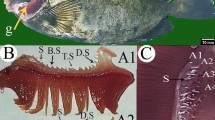Abstract
Periodicities in siphon extension behavior, which is considered an index of feeding behavior, of the Manila clam Ruditapes philippinarum were investigated by sequential visual observations in water tanks under laboratory conditions. Most clams actively extended their siphons in the dark period and closed their shells in the light period under the 12L:12D condition, and this diel cycle of the siphon extension behavior was maintained even under constant light and dark conditions, indicating that Manila clams had an endogenous rhythm with a 24-h cycle. Although the Manila clam has been considered to have a circatidal rhythm in previous studies, a 24.8-h circatidal cycle of the siphon extension behavior was not observed in any of the experimental trials in this study. Although the diel cycle of the siphon extension behavior was temporally collapsed by supplying food after starvation for 10 days, the diel cycle recovered thereafter. This phenomenon indicates that the endogenous rhythm remains even if the cycle of the behavior is lost due to changes in physiological conditions like starvation or in external environments such as food availability.





Similar content being viewed by others
References
Hamaguchi M, Sasaki M, Usuki H (2002) Prevelance of a Perkinsus protozoan in the clam Ruditapes philippinarum in Japan. Jpn J Benthol 57:168–176 (in Japanese with English abstract)
Okoshi K (2007) Unintentionally introduced species the clam-eating moon snail Euspira fortunei. Nippon Suisan Gakkaishi 73:1129–1132 (in Japanense with English abstract)
Hamaguchi M (2011) Relationship among primary production, marine environment and fisheries production of bivalves in the Seto Inland Sea. Bull Fish Res Agen 34:33–47 (in Japanese with English abstract)
Toba M (1989) Significance of amount of ingested food on the sexual maturation of Short-necked clam Ruditapes philippinarum Adams et Reeve (Pelecypoda) rearing in the tank. SUISANZOSHOKU 37:63–69 (in Japanese with English abstract)
Gnyubkin VF (2010) The circadian rhythms of valve movements in the mussel Mytilus galloprovincialis. Rus J Mar Biol 36:419–428
Langton R (1977) Digestive rhythms in the mussel Mytilus edulis. Mar Biol 41:53–58
Langton R, Gabbott P (1974) The tidal rhythm of extracellular digestion and the response to feeding in Ostrea edulis. Mar Biol 24:181–187
Morton B (1970) The tidal rhythm and rhythm of feeding and digestion in Cardium edule. J Mar Biol Ass UK 50:499–512
Morton B (1971) The diurnal rhythm and tidal rhythm of feeding and digestion in Ostrea edulis. Biol J Linn Soc 3:329–342
García-March JR, Solsona MÁS, García-Carrascosa A (2008) Shell gaping behaviour of Pinna nobilis L., 1758: circadian and circalunar rhythms revealed by in situ monitoring. Mar Biol 153:689–698
Englund V, Heino M (1994) Valve movement of Anodonta anatina and Unio tumidus (Bivalvia, Unionidae) in a eutrophic lake. Ann Zool Fennici 31:257–262
Ortmann C, Grieshaber MK (2003) Energy metabolism and valve closure behaviour in the Asian clam Corbicula fluminea. J Exp Biol 206:4167–4178
Bennett MF, Shriner J, Brown RA (1957) Persistent tidal cycles of spontaneous motor activity in the fiddler crab, Uca pugnax. Biol Bull 112:267–275
Rao KP (1954) Tidal rhythmicity of rate of water propulsion in Mytilus, and Its modifiability by transplanation. Biol Bull 106:353–359
Brown FA (1954) Persistent activity rhythms in the oyster. Am J Physiol Leg Con 178:510–514
Masu T, Watanabe S, Aoki S, Katayama S, Fukuda M, Hino A (2008) Establishment of shell growth analysis technique of juvenile Manila clam Ruditapes philippinarum: semidiurnal shell increment formation. Fish Sci 74:41–47
Poulain C, Lorrain A, Flye-Sainte-Marie J, Amice E, Morize E, Paulet Y-M (2011) An environmentally induced tidal periodicity of microgrowth increment formation in subtidal populations of the clam Ruditapes philippinarum. J Exp Mar Bio Ecol 397:58–64
Kim WS, Huh HT, Lee J-H, Rumohr H, Koh CH (1999) Endogenous circatidal rhythm in the Manila clam Ruditapes philippinarum (Bivalvia: Veneridae). Mar Biol 134:107–112
Kim WS, Huh HT, Huh S-H, Lee TW (2001) Effect of salinity on endogenous rhythm of the Manila clam Ruditapes philippinarum (Bivalvia : Veneridae). Mar Biol 138:157–162
Isono R, Kita J, Kishida C (1998) Upper temperature effect on rates of growth and oxygen consumption of the Japanese littleneck clam, Ruditapes philippinarum. Nippon Suisan Gakkaishi 64:373–376 (in Japanese with English abstract)
Isono R, Nakamura Y (2000) Comparative studies of the water filtering rate in marine bivalves, with particular reference to thermal effects. J Jpn Soc Water Environ 23:683–689 (in Japanese with English abstract)
Higgins PJ (1980) Effects of food availability on the valve movements and feeding behavior of juvenile Crassostrea Virginica (Gmelin). I. Valve movements and periodic activity. J Exp Mar Bio Ecol 45:229–244
Williams BG, Pilditch CA (1997) The entrainment of persistent tidal rhythmicity in a filter-feeding bivalve using cycles of food availability. J Biol Rhythms 12:173–181
Jørgensen E (1962) Antibiotic substances from cells and solution of unicellular algae with special reference to some chlorophyll derivatives. Physiol Plant 15:530–545
Chatfield C (1996) The analysis of time series: An introduction, 5th edn. Chapman and Hall, London
Pittendrigh CS (1960) Circadian rhythms and the circadian organization of living systems. In: Cold Spring Harb Sympo Quant Biol. 25: Biological clocks. pp 159–184
Satoh A, Yoshioka E, Numata H (2008) Circatidal activity rhythm in the mangrove cricket Apteronemobius asahinai. Biol Lett 4:233–236
Abe Y, Ushirogawa H, Tomioka K (1997) Circadian locomotor rhythms in the cricket, Gryllodes sigiilatus I. Localization of the pacemaker and the photoreceptor. Zool Sci 14:719–727
Broom DM (1981) Biology of behaviour: Mechanisms, functions and applications. Cambridge University Press, New York
Shigeta T, Usuki H (2012) Predation on the Short-neck clam Ruditapes philippinarum by intertidal fishes: a list of fish predators. J Fish Tech 5:1–19 (in Japanese with English abstract)
Author information
Authors and Affiliations
Corresponding author
Electronic supplementary material
Below is the link to the electronic supplementary material.
Rights and permissions
About this article
Cite this article
Houki, S., Kawamura, T., Irie, T. et al. The daily cycle of siphon extension behavior in the Manila clam controlled by endogenous rhythm. Fish Sci 81, 453–461 (2015). https://doi.org/10.1007/s12562-015-0859-6
Received:
Accepted:
Published:
Issue Date:
DOI: https://doi.org/10.1007/s12562-015-0859-6




